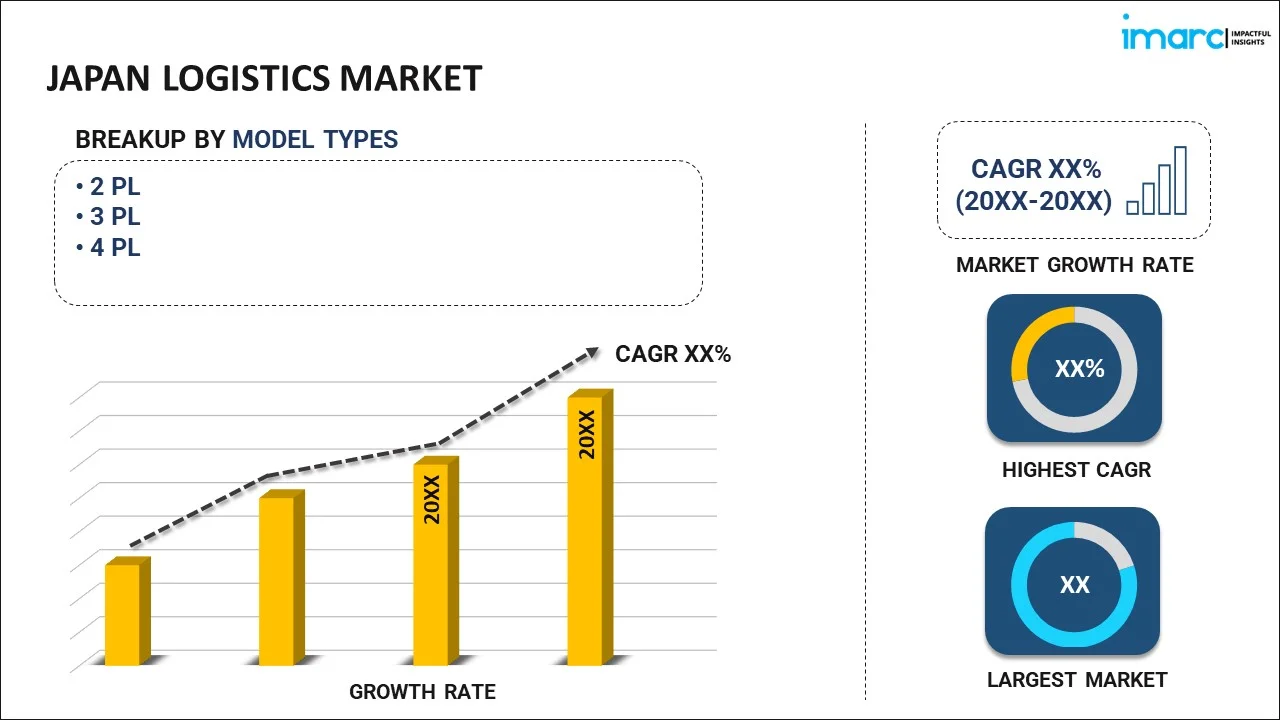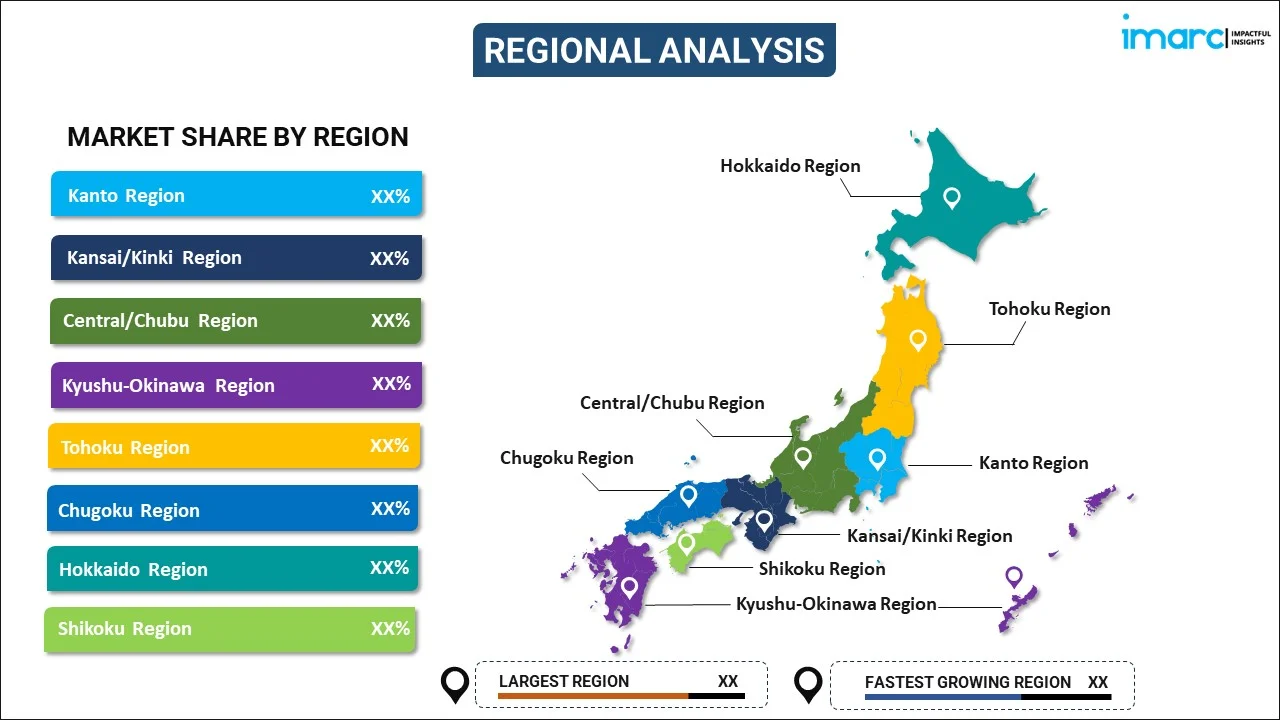
Japan Logistics Market Report by Model Type (2 PL, 3 PL, 4 PL), Transportation Mode (Roadways, Seaways, Railways, Airways), End Use (Manufacturing, Consumer Goods, Retail, Food and Beverages, IT Hardware, Healthcare, Chemicals, Construction, Automotive, Telecom, Oil and Gas, and Others), and Region 2025-2033
Market Overview:
Japan logistics market size reached USD 337 Billion in 2024. Looking forward, IMARC Group expects the market to reach USD 549 Billion by 2033, exhibiting a growth rate (CAGR) of 5.6% during 2025-2033. The rising shift toward sustainable and green logistics practices, increasing reliance of individuals on online shopping platforms, and continuous investments in eco-friendly transportation methods, energy-efficient warehouses, and sustainable packaging solutions represent some of the key factors driving the market.
|
Report Attribute
|
Key Statistics
|
|---|---|
|
Base Year
|
2024
|
|
Forecast Years
|
2025-2033
|
|
Historical Years
|
2019-2024
|
|
Market Size in 2024
|
USD 337 Billion |
|
Market Forecast in 2033
|
USD 549 Billion |
| Market Growth Rate 2025-2033 | 5.6% |
Logistics refers to the management of the flow of goods, services, and information between the point of origin and the point of consumption systematically and efficiently. It includes planning, implementing, and controlling various processes to ensure the smooth and cost-effective movement of products and services. It involves coordination among various elements of the supply chain, such as transportation, warehousing, and inventory management. It emphasizes delivering products and services to individuals at the right time. It can help mitigate risks related to supply chain disruptions. It reduces transportation and storage costs, leading to overall cost savings. It ensures a steady supply of raw materials and components to manufacturing facilities and the distribution of finished products. It is widely used in the e-commerce industry for order processing, warehousing, and last-mile delivery. It is also utilized in the healthcare sector for the timely delivery of medical supplies and equipment to hospitals and clinics. Besides this, it also finds applications in military operations, including the movement of troops, equipment, and supplies.
Japan Logistics Market Trends:
The ongoing expansion of global trade, particularly with countries in the Asia-Pacific region, represents one of the primary factors catalyzing the demand for logistics services in Japan. Additionally, the expanding elderly population base in the country and the escalating demand for healthcare and pharmaceutical logistics, including the distribution of medical supplies and equipment, are stimulating the market growth. Along with this, the rising shift toward sustainable and green logistics practices due to the growing environmental concerns is influencing the market positively. Leading market players are investing in eco-friendly transportation methods, energy-efficient warehouses, and sustainable packaging solutions. Apart from this, the logistics industry in Japan is adopting various cutting-edge technologies, such as the Internet of Things (IoT), artificial intelligence (AI), and automation, to optimize warehouse operations, route planning, and inventory management, resulting in greater efficiency and cost savings. Moreover, many businesses in Japan are recognizing the advantages of outsourcing their logistics operations to third-party providers. This allows them to focus on their core competencies while leveraging the expertise and infrastructure of logistics companies. Besides this, companies are investing in robust contingency plans and resilient supply chain systems to ensure the uninterrupted flow of goods during emergencies. Besides this, the rising cross-border e-commerce activities are favoring the market growth. Logistics providers are adapting to handle the complexities of international shipping, customs clearance, and returns processing associated with cross-border e-commerce transactions. In addition to this, the governing authorities of the country are focusing on streamlining customs procedures, reducing red tape, and promoting a business-friendly environment. These changes are expected to attract more international players and foster competition across the country.
Japan Logistics Market Segmentation:
IMARC Group provides an analysis of the key trends in each segment of the market, along with forecasts at country levels for 2025-2033. Our report has categorized the market based on model type, transportation mode, and end use.
Model Type Insights:

- 2 PL
- 3 PL
- 4 PL
The report has provided a detailed breakup and analysis of the market based on the model type. This includes 2 PL, 3 PL, and 4 PL.
Transportation Mode Insights:
- Roadways
- Seaways
- Railways
- Airways
A detailed breakup and analysis of the market based on the transportation mode have also been provided in the report. This includes roadways, seaways, railways, and airways.
End Use Insights:
- Manufacturing
- Consumer Goods
- Retail
- Food and Beverages
- IT Hardware
- Healthcare
- Chemicals
- Construction
- Automotive
- Telecom
- Oil and Gas
- Others
The report has provided a detailed breakup and analysis of the market based on the end use. This includes manufacturing, consumer goods, retail, food and beverages, IT hardware, healthcare, chemicals, construction, automotive, telecom, oil and gas, and others.
Regional Insights:

- Kanto Region
- Kansai/Kinki Region
- Central/ Chubu Region
- Kyushu-Okinawa Region
- Tohoku Region
- Chugoku Region
- Hokkaido Region
- Shikoku Region
The report has also provided a comprehensive analysis of all the major regional markets, which include Kanto Region, Kansai/Kinki Region, Central/ Chubu Region, Kyushu-Okinawa Region, Tohoku Region, Chugoku Region, Hokkaido Region, and Shikoku Region.
Competitive Landscape:
The market research report has also provided a comprehensive analysis of the competitive landscape in the market. Competitive analysis such as market structure, key player positioning, top winning strategies, competitive dashboard, and company evaluation quadrant has been covered in the report. Also, detailed profiles of all major companies have been provided.
Japan Logistics Market Report Coverage:
| Report Features | Details |
|---|---|
| Base Year of the Analysis | 2024 |
| Historical Period | 2019-2024 |
| Forecast Period | 2025-2033 |
| Units | Billion USD |
| Scope of the Report | Exploration of Historical and Forecast Trends, Industry Catalysts and Challenges, Segment-Wise Historical and Predictive Market Assessment:
|
| Model Types Covered | 2 PL, 3 PL, 4 PL |
| Transportation Modes Covered | Roadways, Seaways, Railways, Airways |
| End Uses Covered | Manufacturing, Consumer Goods, Retail, Food and Beverages, IT Hardware, Healthcare, Chemicals, Construction, Automotive, Telecom, Oil and Gas, Others |
| Regions Covered | Kanto Region, Kansai/Kinki Region, Central/ Chubu Region, Kyushu-Okinawa Region, Tohoku Region, Chugoku Region, Hokkaido Region, Shikoku Region |
| Customization Scope | 10% Free Customization |
| Post-Sale Analyst Support | 10-12 Weeks |
| Delivery Format | PDF and Excel through Email (We can also provide the editable version of the report in PPT/Word format on special request) |
Key Questions Answered in This Report:
- How has the Japan logistics market performed so far and how will it perform in the coming years?
- What has been the impact of COVID-19 on the Japan logistics market?
- What is the breakup of the Japan logistics market on the basis of model type?
- What is the breakup of the Japan logistics market on the basis of transportation mode?
- What is the breakup of the Japan logistics market on the basis of end use?
- What are the various stages in the value chain of the Japan logistics market?
- What are the key driving factors and challenges in the Japan logistics?
- What is the structure of the Japan logistics market and who are the key players?
- What is the degree of competition in the Japan logistics market?
Key Benefits for Stakeholders:
- IMARC’s industry report offers a comprehensive quantitative analysis of various market segments, historical and current market trends, market forecasts, and dynamics of the Japan logistics market from 2019-2033.
- The research report provides the latest information on the market drivers, challenges, and opportunities in the Japan logistics market.
- Porter's five forces analysis assist stakeholders in assessing the impact of new entrants, competitive rivalry, supplier power, buyer power, and the threat of substitution. It helps stakeholders to analyze the level of competition within the Japan logistics industry and its attractiveness.
- Competitive landscape allows stakeholders to understand their competitive environment and provides an insight into the current positions of key players in the market.
Need more help?
- Speak to our experienced analysts for insights on the current market scenarios.
- Include additional segments and countries to customize the report as per your requirement.
- Gain an unparalleled competitive advantage in your domain by understanding how to utilize the report and positively impacting your operations and revenue.
- For further assistance, please connect with our analysts.

 Inquire Before Buying
Inquire Before Buying
 Speak to an Analyst
Speak to an Analyst
 Request Brochure
Request Brochure
 Request Customization
Request Customization



.webp)




.webp)












